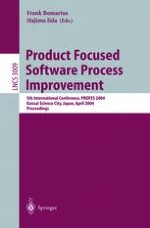On behalf of the PROFES organizing committee we are proud to present to you the proceedings of the 5th International Conference on Product Focused Software Process Improvement (PROFES 2004), held in Kansai Science City, Japan. Since 1999, PROFES has established itself as one of the recognized international process improvement conferences. In 2004 the conference left Europe for the first time and moved to Japan. Japan and its neighboring countries are intensifying their efforts to improve software engineering excellence, so it was a logical step to select Japan as the venue for PROFES 2004. The purpose of the conference is to bring to light the most recent findings and results in the area and to stimulate discussion between researchers, experienced professionals, and technology providers. The large number of participants coming from industry confirms that the conference provides a variety of up-to-date topics and tackles industry problems. The main theme of PROFES is professional software process improvement (SPI) motivated by product and service quality needs. SPI is facilitated by software process assessment, software measurement, process modeling, and technology transfer. It has become a practical tool for quality software engineering and management. The conference addresses both the solutions found in practice and the relevant research results from academia. This is reflected in the 41 full papers, which are a balanced mix of academic papers as well as industrial experience reports.
